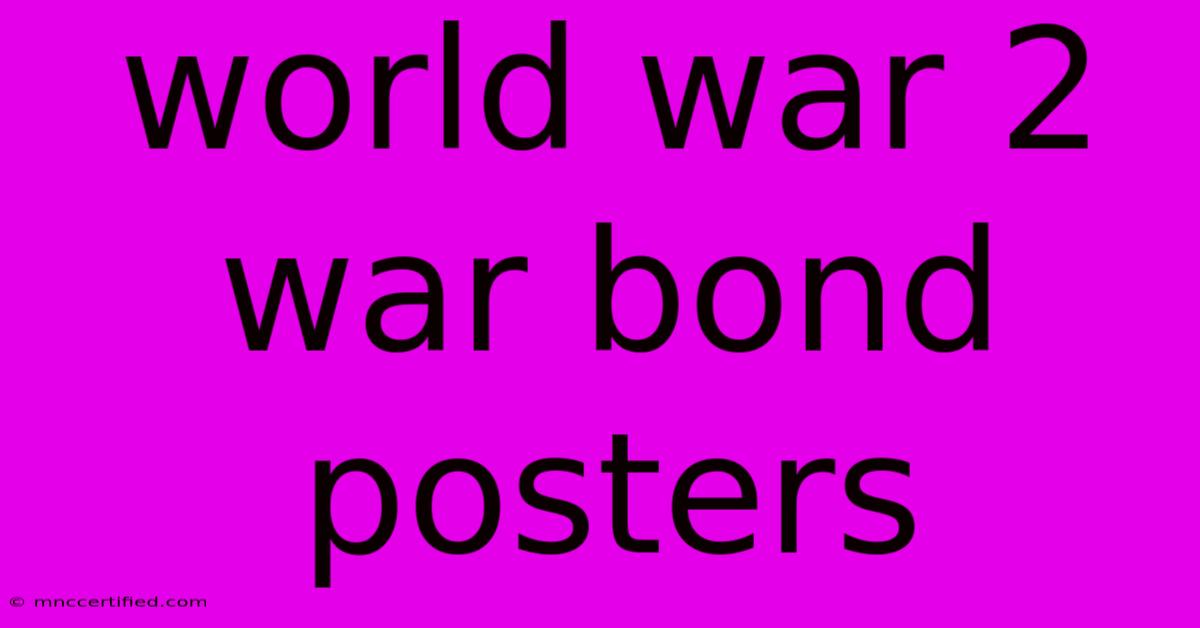World War 2 War Bond Posters

Table of Contents
World War II War Bond Posters: Propaganda Powerhouses and Works of Art
World War II's iconic war bond posters weren't just advertisements; they were powerful pieces of propaganda, meticulously crafted to sway public opinion and raise crucial funds for the war effort. These vibrant images, employing compelling imagery and persuasive text, represent a fascinating intersection of art, history, and social psychology. This article delves into the world of WWII war bond posters, exploring their design, impact, and lasting legacy.
The Power of Persuasion: Design Elements and Techniques
The effectiveness of these posters stemmed from a sophisticated understanding of persuasive techniques. Designers employed several key elements:
-
Patriotic Imagery: Flags, eagles, Uncle Sam, and depictions of American soldiers were frequently used to evoke strong feelings of nationalism and duty. These symbols tapped into deeply ingrained patriotic sentiments, instantly connecting with the viewer's sense of national identity.
-
Emotional Appeals: Posters frequently used emotional appeals, ranging from fear (showing the devastating consequences of defeat) to hope (depicting a victorious future). Images of families, children, and loved ones were strategically employed to tug at the heartstrings and create a personal connection with the cause.
-
Simple, Direct Messaging: The messaging was clear, concise, and easily understood. Long, complex sentences were avoided in favor of short, impactful slogans and calls to action. This ensured the message resonated even with those with limited literacy. Examples include the famous "Buy War Bonds" and more specific calls like "Invest in Victory."
-
Bold Typography and Color: The use of bold typography and vibrant colors ensured the posters were eye-catching and memorable. Designers understood that a poster's visual impact was crucial in grabbing attention in a crowded public space.
-
Celebrity Endorsements: Many posters featured popular celebrities of the time, leveraging their influence and popularity to encourage bond purchases. This added a layer of trustworthiness and social proof, convincing individuals that buying bonds was the right thing to do.
Beyond the Poster: The Social and Cultural Impact
The war bond poster campaign was a massive undertaking, impacting not only the war effort but also the cultural landscape of the time.
-
Funding the War: The posters played a pivotal role in raising billions of dollars, financing the war's massive expenses. This citizen participation was crucial to the Allied victory.
-
Promoting National Unity: The campaign fostered a sense of national unity and collective purpose, uniting Americans in a common cause. The posters promoted the idea that every citizen had a role to play in securing victory.
-
Shaping Public Opinion: The consistent messaging and imagery in the posters helped shape public opinion, reinforcing support for the war and discouraging dissent.
-
Artistic Legacy: Many of the posters are considered significant works of art, showcasing the talent and skill of the graphic designers and illustrators who created them. They offer a fascinating glimpse into the artistic styles and sensibilities of the era.
Where to Find and Learn More
Numerous museums and online archives house collections of WWII war bond posters. Researching these resources can provide a deeper understanding of their design, context, and impact. Searching for terms like "World War II poster art," "war bond posters," and "propaganda posters WWII" will yield a wealth of information.
Conclusion: A Lasting Legacy
World War II war bond posters remain a potent symbol of a pivotal moment in history. These visually compelling pieces of propaganda not only financed the war effort but also shaped public opinion, promoted national unity, and left a lasting artistic legacy. Their study offers valuable insights into the power of visual communication, the dynamics of wartime propaganda, and the enduring spirit of a nation united in a common cause. Their enduring appeal lies in their ability to connect us to a crucial moment in history, reminding us of the sacrifices made and the power of collective action.

Thank you for visiting our website wich cover about World War 2 War Bond Posters. We hope the information provided has been useful to you. Feel free to contact us if you have any questions or need further assistance. See you next time and dont miss to bookmark.
Featured Posts
-
3303 Sw Bond Ave Portland Or
Nov 30, 2024
-
Fraud Charge Transport Secretary Steps Down
Nov 30, 2024
-
Chiefs Mahomes Sets Td Pass Record
Nov 30, 2024
-
10 Bond Street Great Neck Ny
Nov 30, 2024
-
47 Bond St New York Ny 10012
Nov 30, 2024